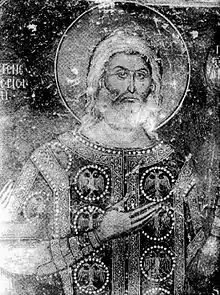Kesar Novak
Kesar Novak (serbisch-kyrillisch Кесар Новак; mittelgriechisch Καίσαρ Νόβακος; eigentlich Novak Mrasorović [?]; † nach 1369) war ein serbischer Magnat, der unter Zar Stefan Uroš V. die hohe Würde eines Kaisars (serbisch Kesar) trug.[1]

Die familiäre Herkunft Novaks ist ebenso unbekannt wie sein Geburts- und Todesdatum. Mit seiner griechischen Frau Kale hatte er eine Tochter Maria und einen Sohn Amiral. Als Vasall des Vukašin Mrnjavčević kontrollierte Novak die Region am Prespasee. Auf der kleinen Insel Mali Grad stiftete er 1369 die Theotokos-Kirche des Höhlenklosters von Bogorodica, in der griechische Inschriften und Fresken erhalten sind, die Novak und seine Familie darstellen.[2]
Literatur
- Saška Bogevska: Notes on Female Piety in Hermitages of the Ohrid and Prespa Region: The Case of Mali Grad. In: Lioba Theis, Margaret Mullett, Michael Grünbart (Hrsg.): Female Founders in Byzantium and Beyond (= Wiener Jahrbuch für Kunstgeschichte. Bd. 60/61, ISSN 0083-9981). Böhlau, Wien 2014, ISBN 978-3-205-78840-9, S. 355–367.
- Иван M. Ђорђевић: Зидно сликарство српске властеле у доба Немањића. Филозофски факулте, Београд 1994, ISBN 86-80269-15-8, S. 84–85.
- Божидар Ферјанчић: Севастократори и кесари у Српском царству. In: Зборник Филозофског факултета. Bd. 10-1, 1970, ISSN 0352-5546, S. 255–269 (Digitalisat), hier: S. 265 f.
- Constantin Jireček: Geschichte der Serben. Bd. 1: Bis 1371. Perthes, Gotha 1911 (Nachdruck Adolf M. Hakkert, Amsterdam 1967), S. 415, 433.
- Раде Михаљчић: Крај Српског царства. Београдски издавачко-графички завод, Београд 1975, S. 319.
- George Christos Soulis: The Serbs and Byzantium during the Reign of Tsar Stephen Dušan (1331–1355) and his Successors. Dumbarton Oaks Research Library and Collection, Washington D.C. 1984, ISBN 0-88402-137-8, S. 214–215.
- Antoine Stransky: Remarques sur la peinture du Moyen âge en Bulgarie, en Grèce et en Albanie. (Actes de IVe Congrès international des études byzantines. Sofia, September 1934). In: Известия на Булгарския Археологицеский Институт. Bd. 10, 1936, ISSN 1311-3224, S. 37–47, hier: S. 42 f.
- Erich Trapp, Hans-Veit Beyer, Ewald Kislinger: Prosopographisches Lexikon der Palaiologenzeit. 8. Faszikel: Μιχαὴλ – Ξυστούρης (= Veröffentlichungen der Kommission für Byzantinistik. Bd. 1/8). Österreichische Akademie der Wissenschaften, Wien 1986, ISBN 3-7001-0775-7, S. 179–180 Nr. 20691.
- Tania Velmans: La Peinture murale byzantine à la fin du Moyen âge. Bd. 1 (= Bibliothèque des Cahiers archéologiques. Bd. 11). Klincksieck, Paris 1977, ISBN 2-252-01896-8.
Anmerkungen
- Vgl. PLP 8, S. 179.
- Vgl. Velmans, Peinture, S. 178.
This article is issued from Wikipedia. The text is licensed under Creative Commons - Attribution - Sharealike. Additional terms may apply for the media files.